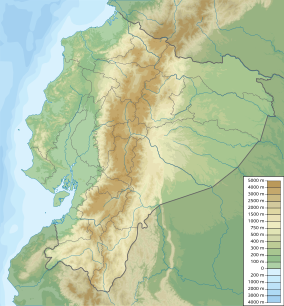| Sumaco Napo-Galeras National Park | |
|---|---|
IUCN category II (
national park) | |
 | |
| Location | Napo Province, and Orellana Province |
| Coordinates | 0°23′0″S 77°33′0″W / 0.38333°S 77.55000°W |
| Area | 206,749 ha |
| Established | 1994 |
Sumaco Napo-Galeras National Park ( Spanish: Parque Nacional Sumaco Napo-Galeras) is a protected area in Ecuador situated in the Napo Province, Orellana Province and Sucumbíos Province. The highest point of the park is the Sumaco volcano that peaks at 3,732 m; the lowest altitude is 600 m. [1] [2]
Fauna
Some 280 birds species are known from the park, but the true number is probably much higher because the park is little explored. Notable birds include Dysithamnus occidentalis, Touit stictoptera, Ara militaris, and Galbula pastazae. [2] A mammal survey conducted at 2500 m on the eastern slope of Sumaco revealed 17 species, including eight species of bats. [3] Larger mammals include Panthera onca, Tremarctos ornatus, Myrmecophaga tridactyla, Tapirus pinchaque, and Puma concolor. [2] Little information exists on other groups, but it is assumed that the diversity of amphibians and reptiles is particularly high. [2] Indeed, a number of amphibians are only known from the area, including toad Osornophryne sumacoensis that is only known from the eastern slopes of Sumaco. [4] [5] Similarly, Pristimantis ernesti is only known from the summit of Sumaco. [6] [7]
References
- ^ "Parque nacional Sumaco". Ministerio del Ambiente. Retrieved 8 February 2015.
- ^ a b c d "Important Bird Areas factsheet: Parque Nacional Sumaco-Napo Galeras". BirdLife International. 2015. Retrieved 8 February 2015.
- ^ Lee, T. E.; Burneo, S. F.; Marchán, M. R.; Roussos, S. A.; Vizcarra-Váscomez, R. S. (2008). "The mammals of the temperate forests of Volcán Sumaco, Ecuador" (PDF). Occasional Papers, Museum of Texas Tech University. 276: 1–10.
-
^ Coloma, L.A., Ron, S., Cisneros-Heredia, D. & Almandáriz, A. (2004).
"Osornophryne sumacoensis".
IUCN Red List of Threatened Species. 2004: e.T54859A11203411.
doi:
10.2305/IUCN.UK.2004.RLTS.T54859A11203411.en.
{{ cite journal}}: CS1 maint: multiple names: authors list ( link) -
^ Coloma, L. A., Páez-Moscoso, D., Frenkel, C., Félix-Novoa, C. y Quiguango-Ubillús, A. (2014).
"Osornophryne sumacoensis". Ron, S. R., Guayasamin, J. M., Yanez-Muñoz, M. H., Merino-Viteri, A., Ortiz, D. A. y Nicolalde, D. A. 2014. AmphibiaWebEcuador. Version 2014.0. Museo de Zoología,
Pontificia Universidad Católica del Ecuador (QCAZ). Archived from
the original on 3 February 2015. Retrieved 8 February 2015.
{{ cite web}}: CS1 maint: multiple names: authors list ( link) -
^ Lynch, J., Coloma, L.A. & Ron, S. (2004).
"Pristimantis ernesti".
IUCN Red List of Threatened Species. 2004: e.T56585A11488039.
doi:
10.2305/IUCN.UK.2004.RLTS.T56585A11488039.en.
{{ cite journal}}: CS1 maint: multiple names: authors list ( link) -
^ Frenkel, C., Yánez-Muñoz, M. H., Guayasamín, J. M., Varela-Jaramillo, A. y Ron, S. R. 2013. AmphibiaWebEcuador. Version 2014.0.
"Pristimantis ernesti". Museo de Zoología,
Pontificia Universidad Católica del Ecuador (QCAZ). Archived from
the original on 11 February 2015. Retrieved 11 February 2015.
{{ cite web}}: CS1 maint: multiple names: authors list ( link) CS1 maint: numeric names: authors list ( link)
